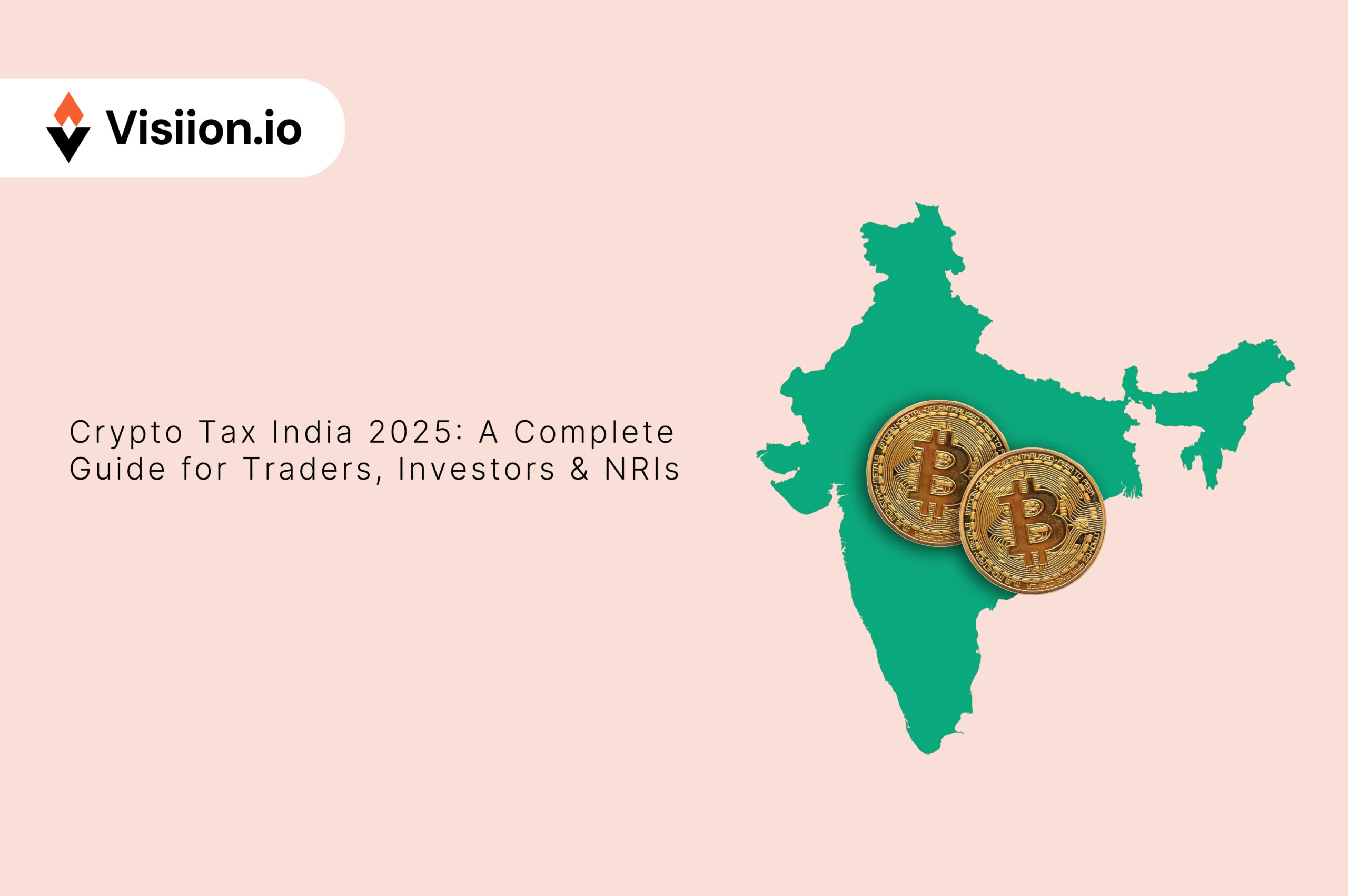Crypto taxation in India is slowly becoming a mainstream discussion point amongst professionals and traders. Recently, the government has placed strict rules in place, and as of 2025, there’s no ambiguity. You buy, sell, earn, or swap crypto; it’s all reportable, and most of it is taxable. But a lot of traders and investors don’t know much about this.
Result? Some of them end up dealing with legal actions from the authority or tax surprise at the end of the financial year. So, to eliminate this confusion, we decided to come up with a detailed Indian Crypto tax Guide.
In this blog, we’ll walk you through important crypto tax regulations, rules and more that you traders should know about. Here, you will get a detailed breakdown that will help any crypto trader or investor stay compliant with the law. But it’s very important that you should consult a tax professional for more detailed advice.
What the Law Calls a Virtual Digital Asset (VDA)?
The Indian government doesn’t just tax Bitcoin and Ethereum. Instead, it uses a broad definition called Virtual Digital Asset (VDA). This term covers:
- Any cryptocurrency (Bitcoin, Ethereum, altcoins)
- Non-fungible tokens (NFTs)
- Tokens received through airdrops, mining, or staking
- Game assets that can be sold for crypto or INR
The Reserve Bank’s Digital Rupee (CBDC) is the only digital asset excluded from crypto tax rule India. Everything else, from your meme coins to airdropped junk tokens, is a VDA and taxed if there’s any monetary gain or transfer.
This classification affects how you’re taxed. For example, if you earn staking rewards or get tokens from airdrops, that income is taxable when received. If you later sell the asset, you’ll pay tax again on any gain over your acquisition price (which was already taxed once as income).
Flat 30% Tax Rule Under Section 115BBH
Every time you sell, swap, or spend a crypto asset, the gain is taxed at a flat 30% as per cryptocurrency taxation India. This rule doesn’t care how long you held it or how you earned it. There are no special tax rates for long-term or short-term gains in crypto.
Here’s what gets taxed:
- Selling crypto for fiat (INR or USD)
- Swapping one crypto for another
- Using crypto to buy goods or services
- Receiving crypto in exchange for freelance work or services
You pay 30% on the profit made, not on the full value. But here’s the catch: the only deduction allowed is your cost of acquisition. No other expenses count. So you cannot get deductions for gas fees, nor platform charges. In fact, you can’t even deduct your electricity costs for mining.
If you bought BTC for ₹50,000 and sold it for ₹80,000, your profit is ₹30,000. The tax is ₹9,000. Add 4% cess on that, and you owe ₹9,360 in total.There’s also no set-off of losses. If you make ₹1,00,000 profit on one coin and ₹90,000 loss on another, you still owe tax on the full ₹1,00,000. You can’t offset losses from one VDA against gains from another. And you can’t carry losses forward either.
1% TDS on Every Sale: Section 194S
Starting July 1, 2022, the government added another layer: Tax Deducted at Source (TDS). Any time you sell crypto and the total transaction value exceeds ₹10,000 in a year (or ₹50,000 if you run a business or file ITR-3), the buyer must deduct 1% of the sale amount and deposit it with the government.
Indian exchanges automatically deduct TDS. But if you’re selling P2P or using foreign exchanges like Binance or OKX, you have to deduct and deposit TDS yourself, yes, even if the other party is anonymous.
Example: Let’s say you sell crypto worth ₹1,00,000. Buyer deducts ₹1,000 as TDS and gives you ₹99,000. That ₹1,000 is credited to your PAN as prepaid tax, and you adjust it at filing time.
If you skip TDS, you risk:
- Penalty equal to the unpaid TDS under Section 271C
- Jail time (3 months to 7 years) under Section 276B
- 15% interest annually for late payment
Many traders using Binance P2P ignored this rule. In early 2025, several of them got tax notices asking for TDS payment proof going back two years. The notices included demand letters with penalties and interest.
So, if you want to stay away from such trouble, make sure you do not ignore the TDS rule. It’s the only way to prevent any legal action from the Income Tax department.
The New 60% Slab for Undisclosed Crypto Under Section 158B
A lot of traders and investors avoided showcasing their crypto assets in their Income Tax Returns. To discourage such individuals, the budget 2025 added a brutal clause. As per this clause, if you fail to report your crypto holdings and the government finds them, through wallet tracking, audit, or compliance checks, you don’t pay 30%. You pay 60%, under Section 158B.
This applies under block assessment or investigation proceedings. In that case, the tax office ignores your explanations and calculates tax on the total value, with no deductions.
Imagine having 10 ETH worth ₹20 lakh that you forgot to report. If found, the tax is ₹12 lakh plus penalty, interest, and maybe prosecution.
It’s not just about “intent to hide.” If the Income Tax Department can prove that you didn’t disclose a crypto wallet or didn’t file Schedule VDA properly, this rule kicks in.
How to File Crypto Taxes India?
Now that you know about crypto tax rules in India, let’s take a look at how to file crypto taxes India. You cannot report crypto gains in ITR-1. That’s a common mistake.
Use:
- ITR-2 if you’re investing, holding long-term, or trading occasionally.
- ITR-3 if you trade daily or treat crypto as business income.
In both forms, you must fill out Schedule VDA. This section asks for:
- Type of asset (coin/NFT)
- Date of acquisition and sale
- Value of sale and purchase
- TDS deducted
- Nature of income (business vs capital gains)
Crypto income appears under different heads based on the context. If you mined it or got it from work, it falls under “Income from Other Sources.” If you earned it from regular trade or speculation, it may go under “Business/Profession.” If you just held and sold for a profit, treat it as a capital gain.
Filing the wrong sections won’t just cause rejection. It can flag your return for scrutiny.
When Does Crypto Trigger a Tax Liability?
There are certain cases when you are liable to pay taxes based on crypto. Here’s the list of these cases:
- Selling crypto for fiat (e.g., INR, USD)
- Swapping ETH for USDT or any crypto-to-crypto transaction
- Spending crypto on any good or service
- Receiving crypto as salary, freelance payment, or business income
- Getting airdrops, staking rewards, or referral bonuses
- Selling NFTs for crypto
- Receiving crypto gifts above ₹50,000 from non-family members
- Receiving mining rewards
Now that you know exactly about the scenarios where crypto triggers crypto tax India 2025, it’s time to check when you don’t owe any tax.
When You Don’t Owe Tax (Yet)
You don’t owe any taxes if you are:
- Just holding crypto (HODLing)
- Transferring crypto between your own wallets
- Receiving crypto gifts under ₹50,000 or from family
- Shifting tokens to a staking pool without earning rewards
- Participating in an ICO but not selling tokens
How the Government Tracks Crypto in 2025?
The Income Tax Department now monitors blockchain wallets, PAN-linked exchange data, and even IP-level activity across major platforms. Indian exchanges report your trades by default. Foreign exchanges and decentralized platforms are now under scrutiny too, especially under the OECD’s new Crypto-Asset Reporting Framework (CARF).
Wallet scanning tools are used in high-value investigations. If your Binance wallet connects to your Indian bank, the trail is visible.
The rule of thumb: if your crypto touches an Indian account, it’s in the tax net.
Special Case: Airdrops, Staking, Mining, NFTs
These sources have their own tax rules, often overlooked by new users.
Airdrops: Taxed on the day of receipt at the fair market value. Reported under “Income from Other Sources.” When you sell them later, pay 30% on gains above the value already taxed.
Staking: The moment staking rewards hit your wallet, treat it as income. Declare under “Other Sources.” When you later sell those coins, calculate capital gain using the previously taxed value as your cost of acquisition.
Mining: If you mine regularly, treat it as business income. Declare the market value of mined crypto on the day you receive it. If you later sell the mined asset, you pay 30% on any additional gain. Electricity bills and hardware depreciation? Not allowed as deductions under Section 115BBH.
NFTs: NFTs sold for crypto or INR are taxed like any other VDA. But you must record the acquisition cost (usually minting fee or platform charges). Royalties from NFTs count as income and are taxed under the slab or business head, depending on your frequency of activity.
What NRIs Must Know?
If you’re an Indian citizen living abroad or an NRI trading Indian crypto pairs, the tax rules still apply. Here’s how:
- If you trade on Indian exchanges (e.g., Visiion.io, CoinDCX, WazirX), they deduct 1% TDS
- You owe 30% on profits made from any trade, regardless of your location
- If you use Indian bank accounts for P2P or deposits, you must file ITR-2 or ITR-3
- If your total income exceeds ₹15 lakh and you spend 120+ days in India during the year, you may trigger tax residency
Also, any undisclosed wallet held abroad can lead to penalties under the Black Money Act. Crypto falls under foreign asset disclosure in Schedule FA if held in overseas exchanges like Coinbase or Kraken.
Wrapping Up
We hope this guide has offered you much-needed clarity on cryptocurrency taxation India. While crypto taxation might feel boring, pro traders always keep an eye out for the same. They know that if they fail to comply, they might end up paying more penalty than the profit they made from trading and investing!
So, it’s better to consult a tax professional and stay compliant. If you liked this blog, feel free to explore our blogs. We regularly come up with helpful insights and guides for crypto traders and investors.
Note: Everything mentioned in this blog is for information purposes only. Please get in touch with your tax consultant for accurate guidance on crypto taxation in India.










